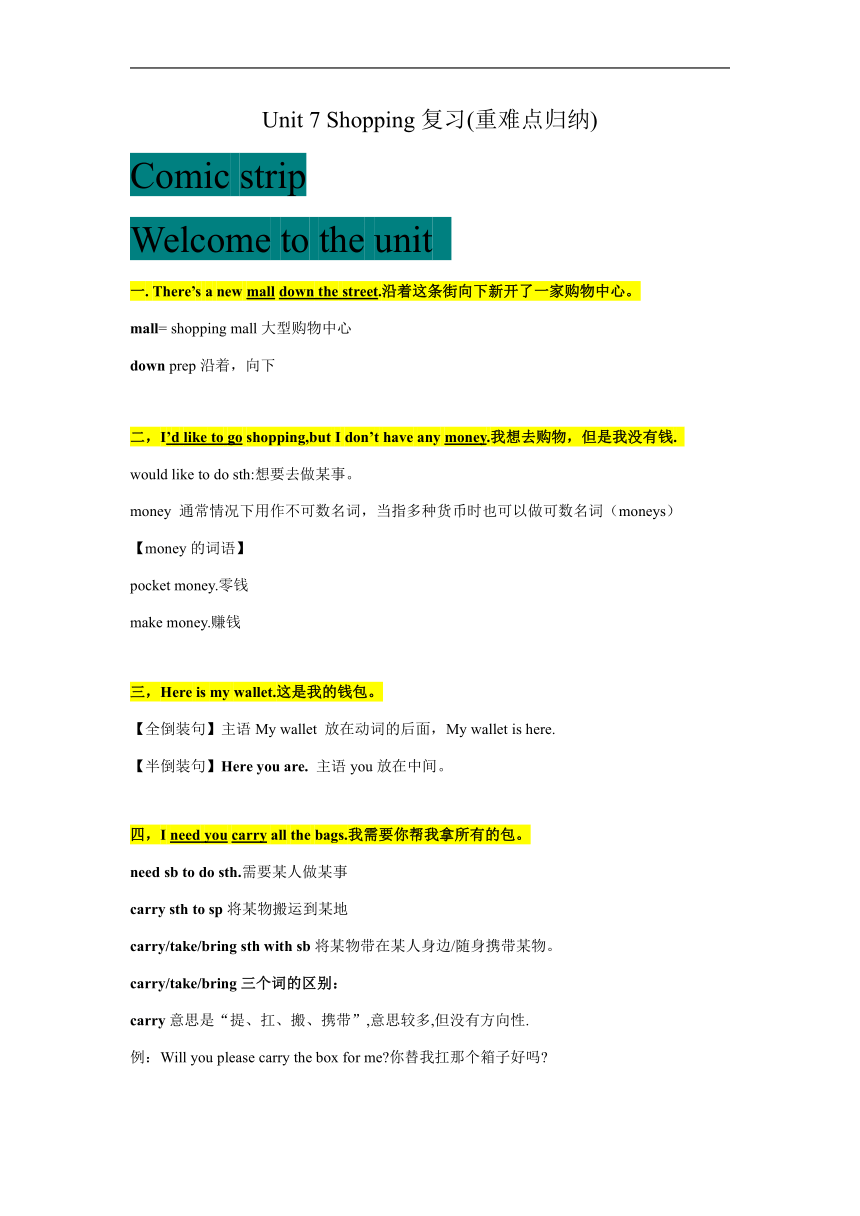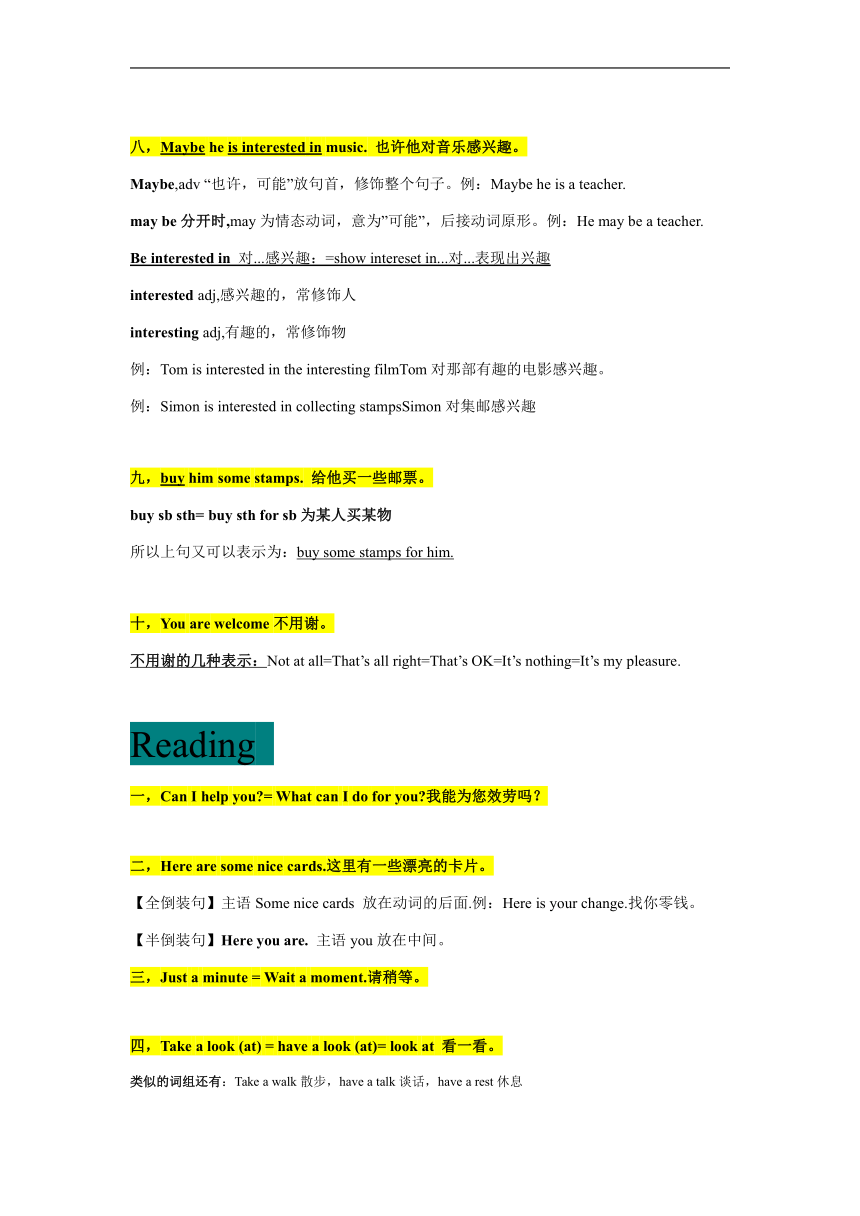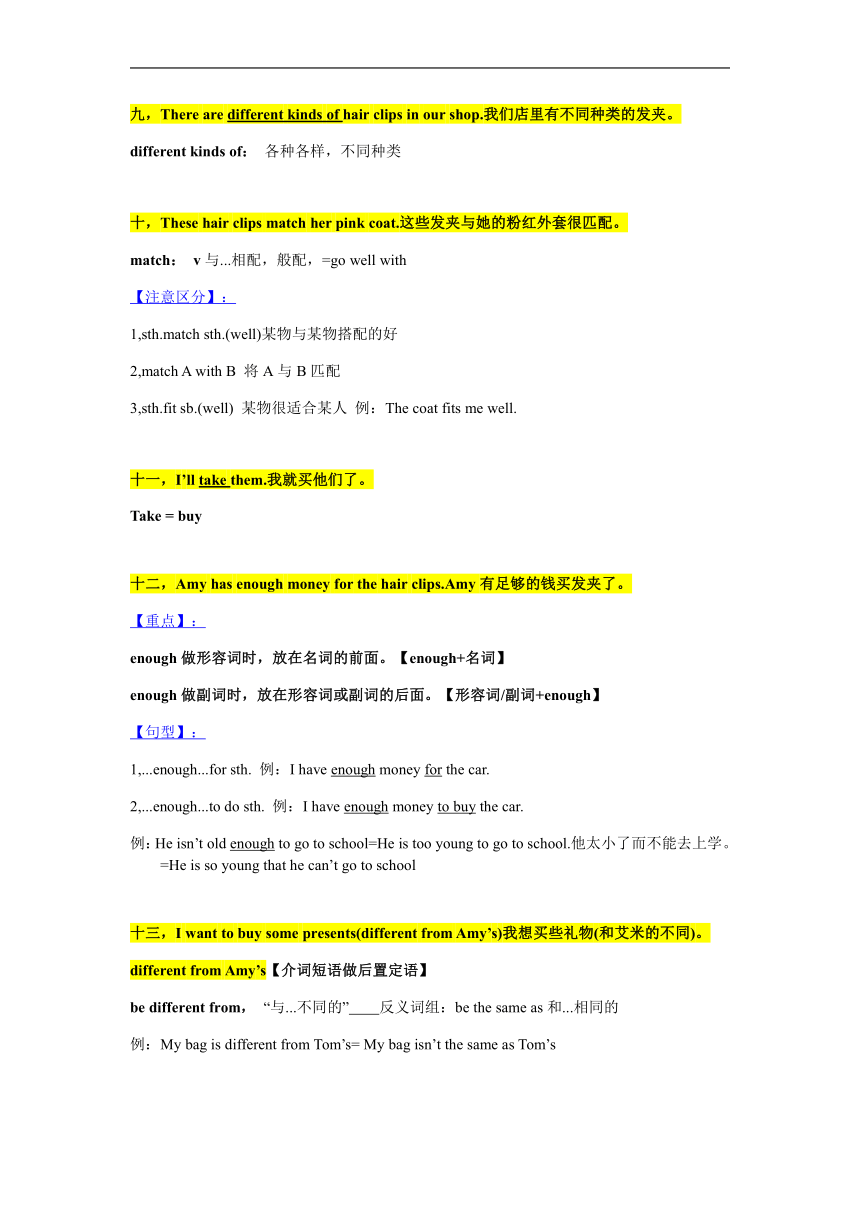牛津译林版七年级上册Unit 7 Shopping复习(重难点归纳)
文档属性
| 名称 | 牛津译林版七年级上册Unit 7 Shopping复习(重难点归纳) |  | |
| 格式 | zip | ||
| 文件大小 | 520.2KB | ||
| 资源类型 | 教案 | ||
| 版本资源 | 牛津译林版 | ||
| 科目 | 英语 | ||
| 更新时间 | 2022-12-10 18:26:01 | ||
图片预览





文档简介
Unit 7 Shopping复习(重难点归纳)
Comic strip
Welcome to the unit
一. There’s a new mall down the street.沿着这条街向下新开了一家购物中心。
mall= shopping mall大型购物中心
down prep沿着,向下
二,I’d like to go shopping,but I don’t have any money.我想去购物,但是我没有钱.
would like to do sth:想要去做某事。
money 通常情况下用作不可数名词,当指多种货币时也可以做可数名词(moneys)
【money的词语】
pocket money.零钱
make money.赚钱
三,Here is my wallet.这是我的钱包。
【全倒装句】主语My wallet 放在动词的后面,My wallet is here.
【半倒装句】Here you are. 主语 you放在中间。
四,I need you carry all the bags.我需要你帮我拿所有的包。
need sb to do sth.需要某人做某事
carry sth to sp将某物搬运到某地
carry/take/bring sth with sb将某物带在某人身边/随身携带某物。
carry/take/bring三个词的区别:
carry意思是“提、扛、搬、携带”,意思较多,但没有方向性.
例:Will you please carry the box for me 你替我扛那个箱子好吗
bring意为“带来,拿来”,把某物或某人从另一个地方带到说话的地方来,也可以说是“由远
及近”.
例:Bring me your dictionary tomorrow.明天把你的词典给我拿来.
take 意为”带走”,把某物或某人从说话的地方带到另一个地方去,也可以说是“由近及远”,
常和介词 to构成搭配.take sth to sw 或随身带走 take sth with sb 随身带着。
例:please take an umbrella with you.请你随身带把伞。
五,名词单复数的用法:
clothes shop服装店:当"衣服,服装"后面必须要加 S--原形是 clothe。cloth 布料/面料。
shoe shop鞋店:shoe 作定语用单数,当鞋子出现时是复数形式 shoes
sports shop运动品商店:
sports 修饰名词时只能用复数形式,例:sports club/运动俱乐部
六,Christmas is coming圣诞节就要来临了。
【位移动词用进行时表将来,比如 come,go,leave,fly等】
例:I am flying to Japan tomorrow/我明天就要飞日本了.
七,I am not sure 我不能确定。
sure,adj 确定,肯定,有把握
【重点用法】
1,be sure of/about sth 确信,对...有把握,例:He is sure of success他自信会成功的
2,be sure to do sth确定做某事,认为句子主语“必定”、“必然会”、“准会”。
例:Be sure to send my regards to your mother.务必代我问候你母亲。
3,be sure+(that)宾从:表示主句主语对宾语从句中涉及的事物所作出的判断,意为“确信某
事一定会......”
例:I'm not sure whether I've met him before.我不能确定以前是否见到过他。
八,Maybe he is interested in music. 也许他对音乐感兴趣。
Maybe,adv “也许,可能”放句首,修饰整个句子。例:Maybe he is a teacher.
may be分开时,may为情态动词,意为”可能”,后接动词原形。例:He may be a teacher.
Be interested in 对...感兴趣:=show intereset in...对...表现出兴趣
interested adj,感兴趣的,常修饰人
interesting adj,有趣的,常修饰物
例:Tom is interested in the interesting filmTom对那部有趣的电影感兴趣。
例:Simon is interested in collecting stampsSimon对集邮感兴趣
九,buy him some stamps. 给他买一些邮票。
buy sb sth= buy sth for sb为某人买某物
所以上句又可以表示为:buy some stamps for him.
十,You are welcome不用谢。
不用谢的几种表示:Not at all=That’s all right=That’s OK=It’s nothing=It’s my pleasure.
Reading
一,Can I help you = What can I do for you 我能为您效劳吗?
二,Here are some nice cards.这里有一些漂亮的卡片。
【全倒装句】主语 Some nice cards 放在动词的后面.例:Here is your change.找你零钱。
【半倒装句】Here you are. 主语 you放在中间。
三,Just a minute = Wait a moment.请稍等。
四,Take a look (at) = have a look (at)= look at 看一看。
类似的词组还有:Take a walk散步,have a talk谈话,have a rest休息
五,How much do they cost =How much (money) are they =What’s the price of them 要多
少钱?
cost:
v值(多少钱),需付费
n 费用,代价,成本 the cost of...
例:这个玩具熊多少钱? How much is the teddy bear
What’s the cost of the teddy bear
【拓展】英语中几个花费的用法:
1,cost: 物做主语,意为”值(多少钱),花费”,
sth cost sb...money某物花费某人多少钱 例:This book cost me 2 dollars。
sth cost ...money 某物花费/值多少钱 例:These stamps cost 20 yuan.
2,take:It 做主语时用 take ,表示做某事花费某人多长时间。
3,spend:人做主语,sb spend(s) some time/money on sth/doing sth. 例:I spend 2 dollars on it.
4,pay:遇到 for 用 pay, sb pay(s) money for sth. 例:I paid 2 dollars for it。
六,Last year’s cards.去年的卡片。
【表示时间的名词也有所有格】
例:Do you know today’s news 今天的新闻(时间的名词所有格)
例:five minutes' walk.五分钟的步行路程(距离的名词所有格)
例:Beijing’s street.北京的街道(地点的名词所有格)
例:China’s history中国的首都.(国家的名词所有格)
七,This year’s cards cost two yuan each.今年的卡片每张两元。
八,I’d like to buy a gift for my friends.我想给朋友们买件礼物。
would like= 'd like 想要,相当于情态动词,愿望请求会更多用它。
would like to do sth.表示说话者喜欢做一些事,而这些事是将来做的,不一定说完就立即去
做。
would like doing sth ,表示说话者喜欢做一些事,这些事是说完话就能立刻去做的。
九,There are different kinds of hair clips in our shop.我们店里有不同种类的发夹。
different kinds of: 各种各样,不同种类
十,These hair clips match her pink coat.这些发夹与她的粉红外套很匹配。
match: v与...相配,般配,=go well with
【注意区分】:
1,sth.match sth.(well)某物与某物搭配的好
2,match A with B 将 A与 B匹配
3,sth.fit sb.(well) 某物很适合某人 例:The coat fits me well.
十一,I’ll take them.我就买他们了。
Take = buy
十二,Amy has enough money for the hair clips.Amy有足够的钱买发夹了。
【重点】:
enough做形容词时,放在名词的前面。【enough+名词】
enough做副词时,放在形容词或副词的后面。【形容词/副词+enough】
【句型】:
1,...enough...for sth. 例:I have enough money for the car.
2,...enough...to do sth. 例:I have enough money to buy the car.
例:He isn’t old enough to go to school=He is too young to go to school.他太小了而不能去上学。
=He is so young that he can’t go to school
十三,I want to buy some presents(different fromAmy’s)我想买些礼物(和艾米的不同)。
different fromAmy’s【介词短语做后置定语】
be different from, “与...不同的” 反义词组:be the same as和...相同的
例:My bag is different from Tom’s= My bag isn’t the same as Tom’s
Integrated skills
一,The children in poor areas.在贫困地区的学生。
in poor areas【介词短语做后置定语】类似的短语有:people in need.
二,learn a lot from books.从书上学习到很多。
a lot和 a lot of的区别:
a lot:”多,很多”可做副词词组,侧重修饰动词,标识数量上的多或者经常。
a lot of:”许多,大量”同 lots of,可修饰可数名词,也可修饰不可数名词。其含义与 many或
much相同。当它们在句中与其他词一起作主语时,谓语动词应与其所修饰的名词或代词在
数上保持一致。
例:Thanks a lot for your help.非常感谢你的帮助。
例:A lot of people are coming to the meeting.有很多人要来参加这次会议。
三,Most of the children=most children 【第一个 most为代词,第二个为形容词】
四,Need books most最需要书。 【这里的 most为副词,(程度上)最高,最大】
五,walk a long way to school.步行很长的路去上学。
六,We can use our pocket money to buy them these things.我们可以用我们的零花钱给他
们买这些东西。
pocket money 零花钱
use... to do...=use...for(doing)....用...来做...
例:We use paper to make planes=We use paper for making planes.
例:Sandy uses her pocket money to buy some CDs .
七,What’s your size =What’s the size of your feet =What size(shoes)do you wear 你穿几
码?
size n “尺码,大小” 例:The size of the apples are difference.
v “丈量,大小测量,测定物的大小” 例:Aman’s shirt is sized by its neck.男子衬衫大
小是按照领口分的。
八,I like this pair of shoe.Can I try them on 我喜欢这双鞋子,我能试穿吗?
try...on【动副词组,代词放中间】
类似的词组还有:
turn on打开 turn off关上 turn up调大 turn down调小
wake up唤醒,put on穿上,take off脱下等
九,They fit me well.它们很适合我。
fit v ”合适,合身” sth fit sb某物很适合某人(多指衣物的尺寸大小合适合身,合脚)
n 尤指衣物”适合,合身”
【注意区分】:
1,match: v”与...相配,般配”,=go well with sth.match sth.(well)某物与某物搭配的好,多用
于服饰之间的搭配
2,sth.fit sb.(well) 某物很适合某人 例:The coat fits me well.
十,That’s too expensive.Can we see another pair(of shoes)省略
太贵了,我能看另外一双吗?
expensive adj昂贵的,高价的 例:The price is very expensive.
anther 代词”另一个,另一些”通常指三者或者三者以上中的另一个。例:I eat two aples,I’d
like to another one=one more【数量上增加】
the other”另一个,其他的”通常表示两者中的另一个
例:Here are two books,one is yours,the other is Tom’s
pair Can we see another pair此处省略(of shoes)【此处的 pair不能换成 one或者 ones】
十一,Price n “价格”
例:What’s the price of... 价格多少?
注意:价格只有高(high)低(low)之分,没有贵(expensive)和便宜(cheap)之说
例:The price of the apples is very high/low=The apples are very expensive/cheap.
Task
一,Notes about Sunshine Shopping Mall.有关阳光购物中心的笔记。
Notes:n “笔记,记录”----take notes 记笔记,make notes about...作有关...的笔记
v “注意,记录,对...加注释”
二,Near a bus stop靠近公共汽车站。
bus stop:n “公共汽车站”指小的停靠点。
bus station:n “公共汽车站”指大型停靠站。
三,There five floors of shops and each floor is big。五层楼的商店,每一层都很大。
类似的还有:one floor of restaurants一层楼的餐馆
【拓展】Western restaurant西餐厅,Chinese restaurant中餐厅,
四,There are foods from different areas.有来自不同地方的食物。
foods,n这里的 food用复数,强调食物的种类。
五,All the restaurants are on the top floor.所有的餐厅都在顶楼。
top,adj 最高的,例:a top student一个尖子生
top,n 顶,顶部,例:on the top of the mountain在山顶
六,The mall is a good place to meet friends and have fun.购物中心是一个会见朋友和玩的开
心的好地方。
【动词不定式作后置定语】
例:The room is a good place for me to study.
例:The library is a good place to read books.
all 要放在冠词、指示代词、物主代词等之前;例: all the family/全家,all her life/她的一生
whole 应放在这些词之后。例: the whole family/全家,her whole life/她的一生
Grammar
Some 和 any的用法:
1,Some“一些”:一般用于肯定句中
注意:在疑问句中,我们再提出建议或者请求时常用 some,表示希望得到对方的肯定的答复
【拓展】some有时意为”某一个”,后面接单数名词。例:some day将来某一天
2,any“一些”:一般用于否定句或疑问句中
注意:any 如果用于肯定句中,则表示”任何或者任何一个”,后面常接单数名词。
例:You can borrow any book from the library你可以从图书馆借任何一本书。
例:White can match any other colour白色能与任何一种别的颜色搭配
There be 句型:
There be 句型遵循一致性原则,用 is还是 are 主要看后面的主语
There be 同时也遵循靠近原则,最近的是单数用 is,最近的是复数
用 are.
There be和 have的区别:
There be 结构:在英语中是一种特殊句式,表示“在什么地方或时间存在什么事”,可
以简单的理解成“某处有某人/某物”。
There be 只是引子,后面才是关键。主语是在 There be的后面
例:There is a book on the table./There are six people in the room.
Have 表示主语“拥有”某人或某物,have表示有的时候,主语一般是人
例:I have a book./ I have short hair
句型结构的区别(表示“有”)
There be 是 there be +sb/sth+时间/地点
Be要根据后面的 sb.或 sth 来变换相应的形势,同时要注意到时态。
例:There was a meeting in this room yesterday(过去时)
Have 是 sb./sth.+have+其他,要根据前面的主语和时态来变换相应形势。
例:He has 2 sons./ I had a dream(过去时)
简单口诀帮助记忆:
There be 有特点,主话放在 be 后面,
单数主语用 is,复数主语用 are,
变否定很简单,be 要把 not 添,
变疑问也不难,把 be 提到 there 前,
肯定句中用 some,否定和疑问换 any,
碰到并列主语时,只看近,不看远,变成近视眼。
肯:There is a book on the desk.
否:There is not a book on the desk.
疑:Is there a book on the desk
肯:There are some books on the desk.肯定句中用 some
否:There are not any books on the desk.否定句中用 any
疑:Are there any books on the desk 疑问句中用 any
肯:There is a pen and two books on the desk.
肯:There are two books and a pen on the desk.
Comic strip
Welcome to the unit
一. There’s a new mall down the street.沿着这条街向下新开了一家购物中心。
mall= shopping mall大型购物中心
down prep沿着,向下
二,I’d like to go shopping,but I don’t have any money.我想去购物,但是我没有钱.
would like to do sth:想要去做某事。
money 通常情况下用作不可数名词,当指多种货币时也可以做可数名词(moneys)
【money的词语】
pocket money.零钱
make money.赚钱
三,Here is my wallet.这是我的钱包。
【全倒装句】主语My wallet 放在动词的后面,My wallet is here.
【半倒装句】Here you are. 主语 you放在中间。
四,I need you carry all the bags.我需要你帮我拿所有的包。
need sb to do sth.需要某人做某事
carry sth to sp将某物搬运到某地
carry/take/bring sth with sb将某物带在某人身边/随身携带某物。
carry/take/bring三个词的区别:
carry意思是“提、扛、搬、携带”,意思较多,但没有方向性.
例:Will you please carry the box for me 你替我扛那个箱子好吗
bring意为“带来,拿来”,把某物或某人从另一个地方带到说话的地方来,也可以说是“由远
及近”.
例:Bring me your dictionary tomorrow.明天把你的词典给我拿来.
take 意为”带走”,把某物或某人从说话的地方带到另一个地方去,也可以说是“由近及远”,
常和介词 to构成搭配.take sth to sw 或随身带走 take sth with sb 随身带着。
例:please take an umbrella with you.请你随身带把伞。
五,名词单复数的用法:
clothes shop服装店:当"衣服,服装"后面必须要加 S--原形是 clothe。cloth 布料/面料。
shoe shop鞋店:shoe 作定语用单数,当鞋子出现时是复数形式 shoes
sports shop运动品商店:
sports 修饰名词时只能用复数形式,例:sports club/运动俱乐部
六,Christmas is coming圣诞节就要来临了。
【位移动词用进行时表将来,比如 come,go,leave,fly等】
例:I am flying to Japan tomorrow/我明天就要飞日本了.
七,I am not sure 我不能确定。
sure,adj 确定,肯定,有把握
【重点用法】
1,be sure of/about sth 确信,对...有把握,例:He is sure of success他自信会成功的
2,be sure to do sth确定做某事,认为句子主语“必定”、“必然会”、“准会”。
例:Be sure to send my regards to your mother.务必代我问候你母亲。
3,be sure+(that)宾从:表示主句主语对宾语从句中涉及的事物所作出的判断,意为“确信某
事一定会......”
例:I'm not sure whether I've met him before.我不能确定以前是否见到过他。
八,Maybe he is interested in music. 也许他对音乐感兴趣。
Maybe,adv “也许,可能”放句首,修饰整个句子。例:Maybe he is a teacher.
may be分开时,may为情态动词,意为”可能”,后接动词原形。例:He may be a teacher.
Be interested in 对...感兴趣:=show intereset in...对...表现出兴趣
interested adj,感兴趣的,常修饰人
interesting adj,有趣的,常修饰物
例:Tom is interested in the interesting filmTom对那部有趣的电影感兴趣。
例:Simon is interested in collecting stampsSimon对集邮感兴趣
九,buy him some stamps. 给他买一些邮票。
buy sb sth= buy sth for sb为某人买某物
所以上句又可以表示为:buy some stamps for him.
十,You are welcome不用谢。
不用谢的几种表示:Not at all=That’s all right=That’s OK=It’s nothing=It’s my pleasure.
Reading
一,Can I help you = What can I do for you 我能为您效劳吗?
二,Here are some nice cards.这里有一些漂亮的卡片。
【全倒装句】主语 Some nice cards 放在动词的后面.例:Here is your change.找你零钱。
【半倒装句】Here you are. 主语 you放在中间。
三,Just a minute = Wait a moment.请稍等。
四,Take a look (at) = have a look (at)= look at 看一看。
类似的词组还有:Take a walk散步,have a talk谈话,have a rest休息
五,How much do they cost =How much (money) are they =What’s the price of them 要多
少钱?
cost:
v值(多少钱),需付费
n 费用,代价,成本 the cost of...
例:这个玩具熊多少钱? How much is the teddy bear
What’s the cost of the teddy bear
【拓展】英语中几个花费的用法:
1,cost: 物做主语,意为”值(多少钱),花费”,
sth cost sb...money某物花费某人多少钱 例:This book cost me 2 dollars。
sth cost ...money 某物花费/值多少钱 例:These stamps cost 20 yuan.
2,take:It 做主语时用 take ,表示做某事花费某人多长时间。
3,spend:人做主语,sb spend(s) some time/money on sth/doing sth. 例:I spend 2 dollars on it.
4,pay:遇到 for 用 pay, sb pay(s) money for sth. 例:I paid 2 dollars for it。
六,Last year’s cards.去年的卡片。
【表示时间的名词也有所有格】
例:Do you know today’s news 今天的新闻(时间的名词所有格)
例:five minutes' walk.五分钟的步行路程(距离的名词所有格)
例:Beijing’s street.北京的街道(地点的名词所有格)
例:China’s history中国的首都.(国家的名词所有格)
七,This year’s cards cost two yuan each.今年的卡片每张两元。
八,I’d like to buy a gift for my friends.我想给朋友们买件礼物。
would like= 'd like 想要,相当于情态动词,愿望请求会更多用它。
would like to do sth.表示说话者喜欢做一些事,而这些事是将来做的,不一定说完就立即去
做。
would like doing sth ,表示说话者喜欢做一些事,这些事是说完话就能立刻去做的。
九,There are different kinds of hair clips in our shop.我们店里有不同种类的发夹。
different kinds of: 各种各样,不同种类
十,These hair clips match her pink coat.这些发夹与她的粉红外套很匹配。
match: v与...相配,般配,=go well with
【注意区分】:
1,sth.match sth.(well)某物与某物搭配的好
2,match A with B 将 A与 B匹配
3,sth.fit sb.(well) 某物很适合某人 例:The coat fits me well.
十一,I’ll take them.我就买他们了。
Take = buy
十二,Amy has enough money for the hair clips.Amy有足够的钱买发夹了。
【重点】:
enough做形容词时,放在名词的前面。【enough+名词】
enough做副词时,放在形容词或副词的后面。【形容词/副词+enough】
【句型】:
1,...enough...for sth. 例:I have enough money for the car.
2,...enough...to do sth. 例:I have enough money to buy the car.
例:He isn’t old enough to go to school=He is too young to go to school.他太小了而不能去上学。
=He is so young that he can’t go to school
十三,I want to buy some presents(different fromAmy’s)我想买些礼物(和艾米的不同)。
different fromAmy’s【介词短语做后置定语】
be different from, “与...不同的” 反义词组:be the same as和...相同的
例:My bag is different from Tom’s= My bag isn’t the same as Tom’s
Integrated skills
一,The children in poor areas.在贫困地区的学生。
in poor areas【介词短语做后置定语】类似的短语有:people in need.
二,learn a lot from books.从书上学习到很多。
a lot和 a lot of的区别:
a lot:”多,很多”可做副词词组,侧重修饰动词,标识数量上的多或者经常。
a lot of:”许多,大量”同 lots of,可修饰可数名词,也可修饰不可数名词。其含义与 many或
much相同。当它们在句中与其他词一起作主语时,谓语动词应与其所修饰的名词或代词在
数上保持一致。
例:Thanks a lot for your help.非常感谢你的帮助。
例:A lot of people are coming to the meeting.有很多人要来参加这次会议。
三,Most of the children=most children 【第一个 most为代词,第二个为形容词】
四,Need books most最需要书。 【这里的 most为副词,(程度上)最高,最大】
五,walk a long way to school.步行很长的路去上学。
六,We can use our pocket money to buy them these things.我们可以用我们的零花钱给他
们买这些东西。
pocket money 零花钱
use... to do...=use...for(doing)....用...来做...
例:We use paper to make planes=We use paper for making planes.
例:Sandy uses her pocket money to buy some CDs .
七,What’s your size =What’s the size of your feet =What size(shoes)do you wear 你穿几
码?
size n “尺码,大小” 例:The size of the apples are difference.
v “丈量,大小测量,测定物的大小” 例:Aman’s shirt is sized by its neck.男子衬衫大
小是按照领口分的。
八,I like this pair of shoe.Can I try them on 我喜欢这双鞋子,我能试穿吗?
try...on【动副词组,代词放中间】
类似的词组还有:
turn on打开 turn off关上 turn up调大 turn down调小
wake up唤醒,put on穿上,take off脱下等
九,They fit me well.它们很适合我。
fit v ”合适,合身” sth fit sb某物很适合某人(多指衣物的尺寸大小合适合身,合脚)
n 尤指衣物”适合,合身”
【注意区分】:
1,match: v”与...相配,般配”,=go well with sth.match sth.(well)某物与某物搭配的好,多用
于服饰之间的搭配
2,sth.fit sb.(well) 某物很适合某人 例:The coat fits me well.
十,That’s too expensive.Can we see another pair(of shoes)省略
太贵了,我能看另外一双吗?
expensive adj昂贵的,高价的 例:The price is very expensive.
anther 代词”另一个,另一些”通常指三者或者三者以上中的另一个。例:I eat two aples,I’d
like to another one=one more【数量上增加】
the other”另一个,其他的”通常表示两者中的另一个
例:Here are two books,one is yours,the other is Tom’s
pair Can we see another pair此处省略(of shoes)【此处的 pair不能换成 one或者 ones】
十一,Price n “价格”
例:What’s the price of... 价格多少?
注意:价格只有高(high)低(low)之分,没有贵(expensive)和便宜(cheap)之说
例:The price of the apples is very high/low=The apples are very expensive/cheap.
Task
一,Notes about Sunshine Shopping Mall.有关阳光购物中心的笔记。
Notes:n “笔记,记录”----take notes 记笔记,make notes about...作有关...的笔记
v “注意,记录,对...加注释”
二,Near a bus stop靠近公共汽车站。
bus stop:n “公共汽车站”指小的停靠点。
bus station:n “公共汽车站”指大型停靠站。
三,There five floors of shops and each floor is big。五层楼的商店,每一层都很大。
类似的还有:one floor of restaurants一层楼的餐馆
【拓展】Western restaurant西餐厅,Chinese restaurant中餐厅,
四,There are foods from different areas.有来自不同地方的食物。
foods,n这里的 food用复数,强调食物的种类。
五,All the restaurants are on the top floor.所有的餐厅都在顶楼。
top,adj 最高的,例:a top student一个尖子生
top,n 顶,顶部,例:on the top of the mountain在山顶
六,The mall is a good place to meet friends and have fun.购物中心是一个会见朋友和玩的开
心的好地方。
【动词不定式作后置定语】
例:The room is a good place for me to study.
例:The library is a good place to read books.
all 要放在冠词、指示代词、物主代词等之前;例: all the family/全家,all her life/她的一生
whole 应放在这些词之后。例: the whole family/全家,her whole life/她的一生
Grammar
Some 和 any的用法:
1,Some“一些”:一般用于肯定句中
注意:在疑问句中,我们再提出建议或者请求时常用 some,表示希望得到对方的肯定的答复
【拓展】some有时意为”某一个”,后面接单数名词。例:some day将来某一天
2,any“一些”:一般用于否定句或疑问句中
注意:any 如果用于肯定句中,则表示”任何或者任何一个”,后面常接单数名词。
例:You can borrow any book from the library你可以从图书馆借任何一本书。
例:White can match any other colour白色能与任何一种别的颜色搭配
There be 句型:
There be 句型遵循一致性原则,用 is还是 are 主要看后面的主语
There be 同时也遵循靠近原则,最近的是单数用 is,最近的是复数
用 are.
There be和 have的区别:
There be 结构:在英语中是一种特殊句式,表示“在什么地方或时间存在什么事”,可
以简单的理解成“某处有某人/某物”。
There be 只是引子,后面才是关键。主语是在 There be的后面
例:There is a book on the table./There are six people in the room.
Have 表示主语“拥有”某人或某物,have表示有的时候,主语一般是人
例:I have a book./ I have short hair
句型结构的区别(表示“有”)
There be 是 there be +sb/sth+时间/地点
Be要根据后面的 sb.或 sth 来变换相应的形势,同时要注意到时态。
例:There was a meeting in this room yesterday(过去时)
Have 是 sb./sth.+have+其他,要根据前面的主语和时态来变换相应形势。
例:He has 2 sons./ I had a dream(过去时)
简单口诀帮助记忆:
There be 有特点,主话放在 be 后面,
单数主语用 is,复数主语用 are,
变否定很简单,be 要把 not 添,
变疑问也不难,把 be 提到 there 前,
肯定句中用 some,否定和疑问换 any,
碰到并列主语时,只看近,不看远,变成近视眼。
肯:There is a book on the desk.
否:There is not a book on the desk.
疑:Is there a book on the desk
肯:There are some books on the desk.肯定句中用 some
否:There are not any books on the desk.否定句中用 any
疑:Are there any books on the desk 疑问句中用 any
肯:There is a pen and two books on the desk.
肯:There are two books and a pen on the desk.
同课章节目录
- 预备课程
- Lesson 1 Nice to meet you !
- Lesson 2 A happy family
- Lesson 3 A nice school
- Lesson 4 You look cool !
- Lesson 5 Wonderful things
- Lesson 6 Have nice food
- Lesson 7 Enjoy our days
- Lesson 8 Let's have fun !
- Unit 1 This is me
- Unit 2 Let's play sports
- Unit 3 Welcome to our school
- Unit 4 My day
- Unit 5 Let’s celebrate
- Unit 6 Food and lifestyle
- Unit 7 Shopping
- Unit 8 Fashion
